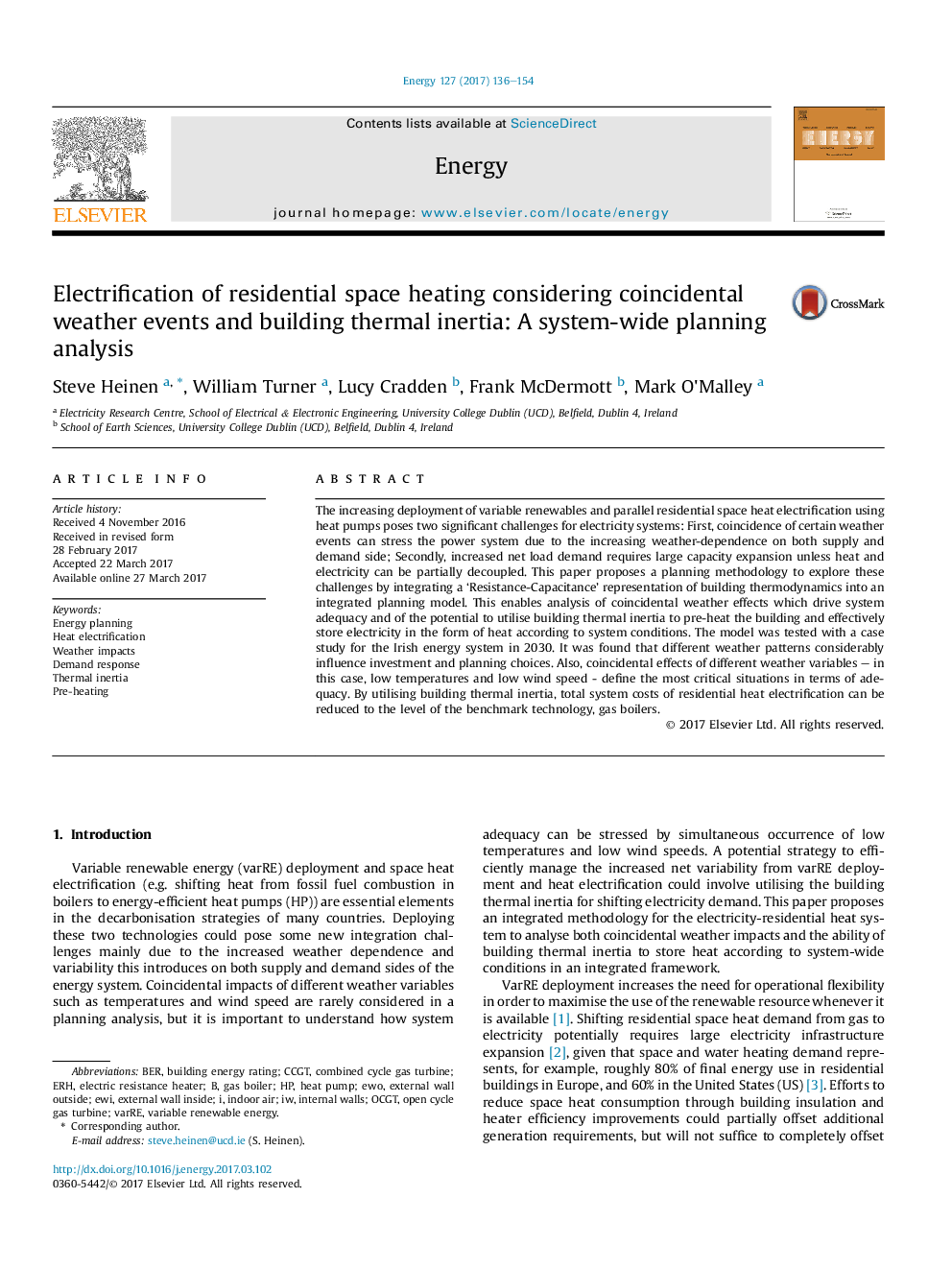| کد مقاله | کد نشریه | سال انتشار | مقاله انگلیسی | نسخه تمام متن |
|---|---|---|---|---|
| 5476797 | 1521424 | 2017 | 19 صفحه PDF | دانلود رایگان |
عنوان انگلیسی مقاله ISI
Electrification of residential space heating considering coincidental weather events and building thermal inertia: A system-wide planning analysis
ترجمه فارسی عنوان
الکتریسیته شدن در محیط های مسکونی به دلیل وقوع حوادث حادثه ای و ایجاد نفوذ حرارتی: تجزیه و تحلیل برنامه ریزی در سطح وسیع
دانلود مقاله + سفارش ترجمه
دانلود مقاله ISI انگلیسی
رایگان برای ایرانیان
کلمات کلیدی
OCGTBERERHCCGTEWIEWOThermal inertia - اینرسی حرارتیEnergy planning - برنامه ریزی انرژیopen cycle gas turbine - توربین گاز چرخه بازCombined cycle gas turbine - توربین گاز چرخه ترکیبیGas boiler - دیگ بخار گازBuilding energy rating - رتبه بندی ساختمان انرژیVariable renewable energy - متغیر انرژی تجدید پذیرIndoor air - هوای داخل ساختمانDemand response - پاسخ تقاضاHeat pump - پمپ حرارتیPre-heating - پیش گرم کردن
ترجمه چکیده
استقرار فزاینده مجتمع های متغیر مجتمع و تأسیسات الکتریکی حرارتی موازی مسکونی با استفاده از پمپ های حرارتی، دو چالش مهم برای سیستم های برق است: اول، وقوع حوادث خاص آب و هوایی می تواند به سیستم قدرت برسد به دلیل افزایش وابستگی هوا به سمت عرضه و تقاضا؛ ثانیا، افزایش تقاضای بار خالص، نیاز به افزایش ظرفیت بزرگ را دارد، مگر اینکه گرما و برق بخشی از آن را جدا کند. این مقاله یک روش برنامه ریزی برای کشف این چالش ها را با ادغام نمایندگی مقاومت-ظرفیت در ساخت ترمودینامیک به یک مدل برنامه ریزی یکپارچه پیشنهاد می کند. این امکان تجزیه و تحلیل اثرات آب و هوایی تصادفی را فراهم می کند که سیستم را کفایت می کند و از امکان نفوذ حرارتی ساختمان برای پیش گرمایش ساختمان استفاده می کند و به طور موثر در شرایط گرما به صورت گرما ذخیره می کند. این مدل با مطالعه موردی برای سیستم انرژی ایرلند در سال 2030 مورد آزمایش قرار گرفت. مشخص شد که الگوهای مختلف آب و هوایی به طور قابل توجهی بر انتخاب سرمایه گذاری و برنامه ریزی تاثیر می گذارند. همچنین، اثرات متقابل متغیرهای مختلف آب و هوایی - در این مورد، دمای پایین و کم سرعت باد - شرایط بحرانی را از لحاظ کفایت تعریف می کنند. با استفاده از اینرسی حرارتی ساختمان، هزینه کل سیستم برق برق مسکونی می تواند به سطح فن آوری معیار، دیگهای گاز کاهش یابد.
موضوعات مرتبط
مهندسی و علوم پایه
مهندسی انرژی
انرژی (عمومی)
چکیده انگلیسی
The increasing deployment of variable renewables and parallel residential space heat electrification using heat pumps poses two significant challenges for electricity systems: First, coincidence of certain weather events can stress the power system due to the increasing weather-dependence on both supply and demand side; Secondly, increased net load demand requires large capacity expansion unless heat and electricity can be partially decoupled. This paper proposes a planning methodology to explore these challenges by integrating a 'Resistance-Capacitance' representation of building thermodynamics into an integrated planning model. This enables analysis of coincidental weather effects which drive system adequacy and of the potential to utilise building thermal inertia to pre-heat the building and effectively store electricity in the form of heat according to system conditions. The model was tested with a case study for the Irish energy system in 2030. It was found that different weather patterns considerably influence investment and planning choices. Also, coincidental effects of different weather variables - in this case, low temperatures and low wind speed - define the most critical situations in terms of adequacy. By utilising building thermal inertia, total system costs of residential heat electrification can be reduced to the level of the benchmark technology, gas boilers.
ناشر
Database: Elsevier - ScienceDirect (ساینس دایرکت)
Journal: Energy - Volume 127, 15 May 2017, Pages 136-154
Journal: Energy - Volume 127, 15 May 2017, Pages 136-154
نویسندگان
Steve Heinen, William Turner, Lucy Cradden, Frank McDermott, Mark O'Malley,
